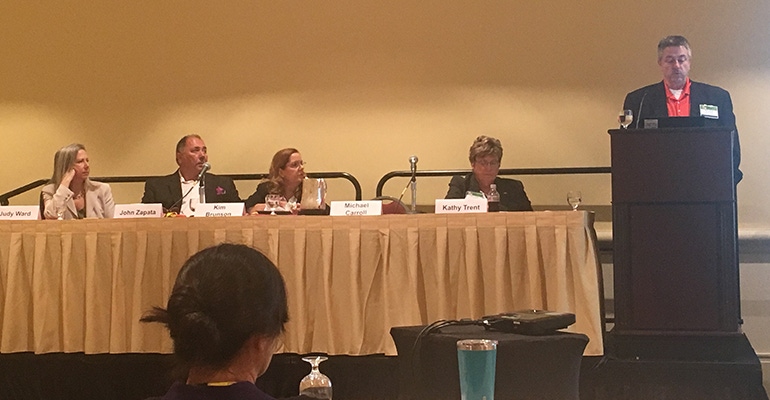The National Waste & Recycling Association (NWRA) held its Executive Leadership Roundtable this week in Orlando, Fla.

The National Waste & Recycling Association (NWRA) held its Executive Leadership Roundtable this week in Orlando, Fla., where leaders of the waste and recycling industry gathered to participate in board and committee meetings and education sessions that covered best practices, emerging trends and issues of critical importance to the industry.
Here are some key takeaways from the NWRA Executive Leadership Roundtable:
NWRA announced its 2017 Recycling Award winners. The awards, which feature six categories, honor companies that have made substantial contributions to the American recycling industry through partnerships, public education, innovations in recycling equipment and innovations in recycling facilities.
At the “Sustainable Stadiums: How the Sports Industry is Becoming Greener” session, Doug Kunnemann of Natureworks and Sissy Burkhart of Major League Baseball's Pittsburgh Pirates discussed the tools they use to manage waste at sporting venues and the challenges that they face.
According to Kunnemann, 81 percent of sports fans are concerned about the environment.
Kunnemann stated that in order to save money in your sporting venue, you need to go green and divert waste.
Kunnemann said that plastics in the ocean are now becoming an issue of plastics in the soil.
Kunnemann also stressed that both recycling and composting are critical to waste diversion. You can't just have one; you need both.
Burkhart said the Pirates launched a program in 2008 based on three areas: recycling (plastics and organics, conservation and education.
Burkhart also pointed out that composting is the only type of recycling that creates a dissimilar virgin product.
Each year, the U.S. foodservice industry purchases about 39 billion pieces of disposable cutlery, approximately 113 billion disposable cups and about 29 billion disposable plates. And only 1 percent of those materials are recycled.
During “The How, What and Why of Setting Sustainability Goals” session, Michael Carroll of the City of Orlando, John Zapata of Rooms-to-Go, Judy Ward of WaWa Stores and Kim Brunson of Publix Super Markets discussed what drives their sustainability goals, how those goals will be achieved and what challenges they need to overcome.
Zapata shared that successful programs have these common ingredients: a genuine desire to be environmentally responsible as a company, executive engagement, investment in people and systems and measurement and tracking.
Ward said that WaWa Stores reduce waste at the point of generation/consumption, divert waste through reuse and recycling, reduce the resources, emissions and costs of collection through compaction and close the loop by creating markets for recovered materials.
Carroll stated that using the term “single cart recycling” instead of “single stream recycling” has been a successful education tool in the City of Orlando.
In the “Packaging, Glass and More” session, Ken Wilkey of Anheuser-Busch, Angus Crane of the North American Insulation Manufacturing Association and Scott Miller of the Knauf Academy shared the innovative ways that they’re approaching recycling and sustainability.
Wilkey said that Anheuser-Busch has a 60/40 glass to cans ratio and that the company is doing some packaging innovations to change that ratio.
Each day, spent grain from Anheuser-Busch’s operations is enjoyed by about 40,000 cows at 15 farms around Jacksonville, Fla.
Crane stated that the association is working to develop better systems for separating glass out of waste streams and that legislation could play a large role in that development process.
Crane also said that the association’s member companies in both the U.S. and Canada used more than 2.2 billion pounds of recycled glass in 2016
There are three main challenges for glass cullet: the supply is not always consistent, contaminants in glass cullet can wreak havoc with the manufacturing process and paper and plastic labels, caps, cork and other debris.
Miller shared that you can save on transportation costs by recycling glass on a local basis.
Miller also said that Knauf goes through 10 rail cars of recycled glass per day.
On October 24, Natural Food Day, Attendees enjoyed a screening of WASTED! The Story of Food Waste, a film that aims to change the way people buy, cook, recycle and eat food.
During the “Disaster Relief: Pre- and Post-Hurricane Planning” session, Jacksonville Beach, Fla., Mayor Charlie Latham, LeMoyne Adams of the Orlando Utilities Commission and Terry Quarles of FEMA talked about how to prepare for the aftermath of a natural disaster.
Latham explained that it’s important to be prepared and to understand that there’s a lot that you can’t predict or handle in a natural disaster situation.
Latham also shared that Hurricane Matthew wiped out 80 percent of Jacksonville Beach’s dunes, which protect the shoreline.
During Hurricane Matthew, 60 percent of Jacksonville Beach residents evacuated, while only 20 percent evacuated during Hurricane Irma, Latham stated.
Jacksonville Beach was able to remove almost all of the debris generated by Hurricane Irma in about four weeks.
During Hurricane Irma, some areas of Jacksonville Beach saw 27 inches of rain in 24 hours.
Adams shared that prior to natural disasters, the Orlando Utilities Commission focuses on safety, food/drink, lodging, transportation, fuel, inventory and more. And after natural disasters, staff members typically work 16-hour days to restore service in affected areas.
About the Author(s)
You May Also Like




